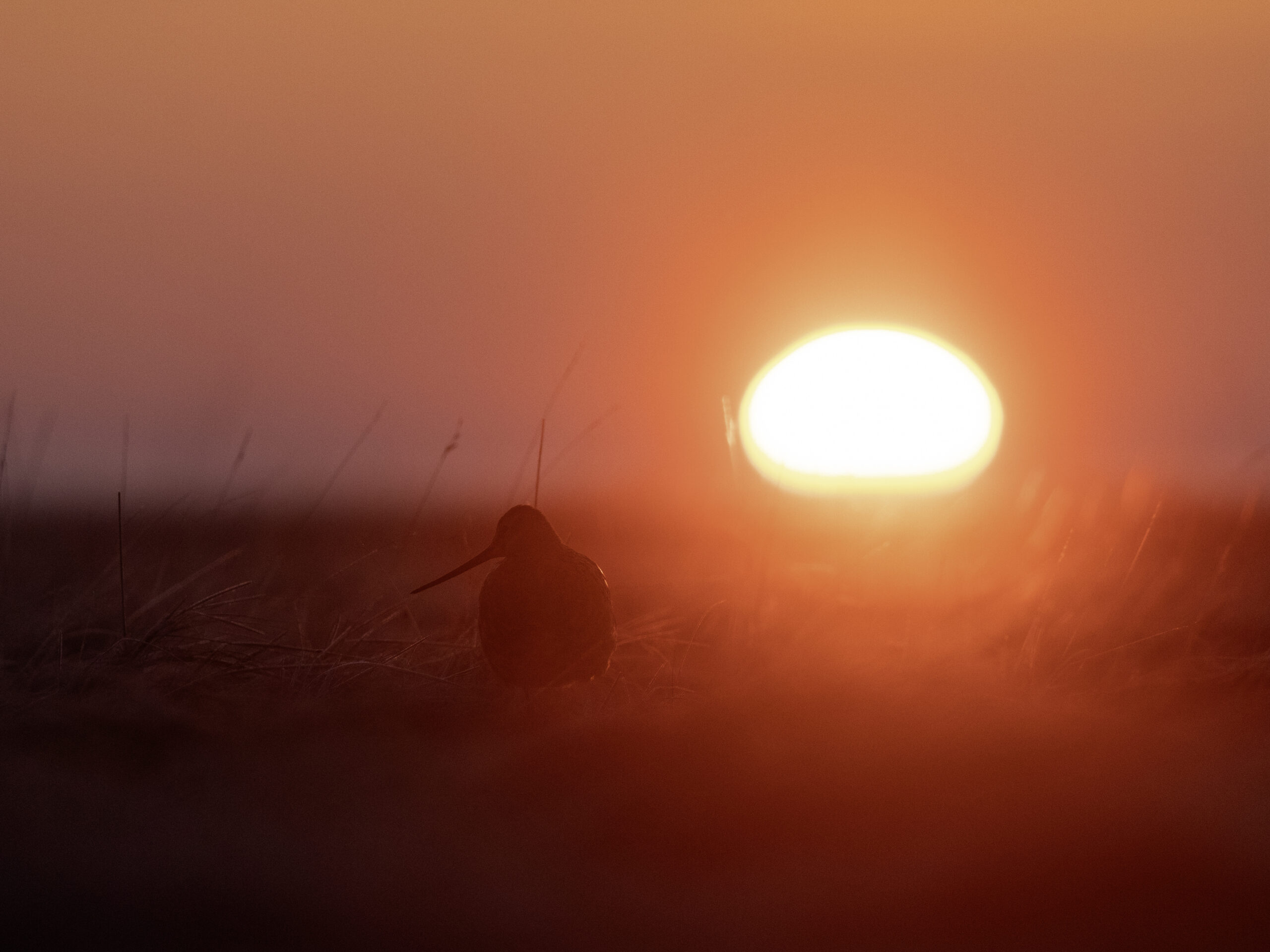
On beings and biomes—the perpetual homecoming of migratory birds
by Dawnell Smith
Three years ago, a four-month-old bar-tailed godwit flew nonstop for 11 days on an 8,425-mile migration from Alaska to Tasmania, Australia—the longest documented nonstop migration by any animal.
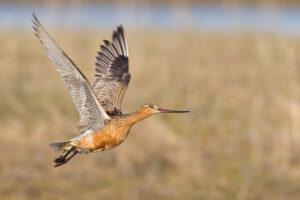
A bar-tailed godwit in flight. Photo by Milo Burcham.
Alaskans, take pride—this long-haul flyer is Alaska born. The bird comes from a sub-species of godwit that breeds only in Alaska.
These godwits flap their wings nonstop the entire journey from the south coast of the Yukon-Kuskokwim Delta of Alaska to their wintering grounds in New Zealand and the southeastern coast of Australia. They lose half their weight on the way and then take the season to fatten up and north to Alaska again.
You may not be a “birder” in the full sense of the word, but you have surely been dazzled by the birds of the world—the godwit, secretary bird, Andean condor, golden pheasant, or the chickadee at your feeder. Our fascination with birds predates our own (lowly) means of flight. Take the Aztec deity Quetzalcoatl, the feathered serpent god, or the phoenix of ancient lore who ignites their nest and self at the end of life so a new bird can rise from the ashes.
There is raven as trickster, owl as sage, and eagle as ancestor. There are birds as creators and wisdom keepers.
“People have forever been in the company of birds,” said Liliana Naves, the director of conservation for Audubon Alaska. “They are part of our daily life, our soundscape, our culture, our food, our economy. They give us information about the world around us.”
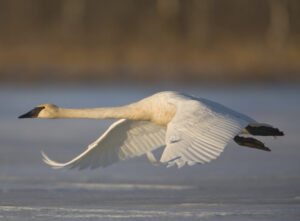
Trumpeter Swan takes off. Photo by Milo Burcham.
Birds are messengers across cultures, she said. Especially migratory birds.
Messengers and soothsayers
People lift their eyes to the sky at the resounding call of birds. In Anchorage this week, a small flock of barking snow geese flew low over Chester Creek, heading south to the Lower 48 or Mexico.
One connection people have with birds relates to their ability to fly and sense what we cannot.
“We get a lot of information from birds,” said Naves, who has twenty years of experience with bird conservation, research, and management. “Migratory birds gather complex information from the environment to make decisions. They are using senses not available to us. They read the weather, environmental features, the magnetic field, so traditionally people have relied on birds for information.”
People have always used birds to help do things like navigate the ocean, determine when to plant or harvest, and set fishing nets. Birds have always been indicators of ecosystem health, too. Where migrating birds go and in what numbers tells us about air quality, the prevalence of pollution, the health of their feeding areas, and more. You might say the old saying, “the canary in the coal mine,” applies to all birds.
Naturally, people have seen the arrival or presence of birds as omens.
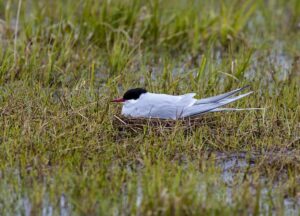
An Arctic tern nests in the grassy wetlands of the western Arctic. Courtesy Bob Wick, BLM
These days, researchers can track and study bird migrations, even to a precise location and wing beat frequency, but we certainly cannot fully understand or begin to experience the fullness of these flights. You can don a squirrel suit and fly 100 mph over a mountainous landscape, but you still won’t know the godwit’s endurance or the twisting upside down and sideways of ravens in playful flight.
Birds live where we do and go where we go. They inhabit forests, tundra, enormous cities, agricultural fields, vast oceans, and yes, near our workplaces and in our backyards. You can see them out the window. Most people can take a moment to notice them daily, even hourly.
A demographic and economic analysis of birding in the United States released in 2024 concludes that over a third of American over 16 years old engage in some form of birding. The report put the total economic output of birding activities in the U.S.—including travel related food, lodging and transportation, plus county, state, and federal tax revenue, and equipment purchases—at $279 billion in 2022. Wow.
Clearly, birds delight us with their varied forms, sizes, dances, songs, colors, and behaviors, and they play vital roles in the health of our shared spaces. They pollinate, nourish the soil, spread seeds, eat insects, provide food, and connect one end of the Earth with the other.
Bird duty
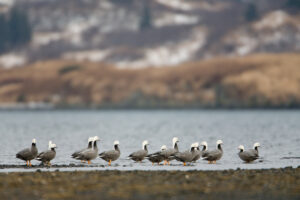
Emperor Geese gather on eelgrass beds. Photo by Milo Burcham.
In the mid-1800s, seabird poop was shipped from Pacific and Caribbean islands to the U.S. as agricultural fertilizer. Chemical fertilizers put the guano trade to rest, but droppings continue to have enormous value to natural landscapes that nourish life. Shorebirds like godwits, sandpipers, plovers, snipes, oystercatchers and phalaropes leave nitrogen-rich droppings across Alaska’s coastline and may support marine and land plants that, in turn, feed other animals.
Emperor and Pacific brant geese eat eelgrass in the Izembek National Wildlife Refuge as part of a unique and essential natural system that nourishes animals and communities. Eelgrass beds support animals like snails, other mollusks, shrimp, and crabs; fish use eelgrass beds for spawning and as a nursery for their young; marine animals like seals and otters hide and hunt for food in these beds.
Local people need healthy eelgrass beds and bird migrations, too, for their food, especially in the spring when their winter food caches run low as well as in the fall before winter sets in. People hunt the geese who migrate to and from Izembek to sustain their food supply, traditions, and connections with each other. In recent years, possibly due to the warming climate, more and more Pacific brant have wintered in Izembek.
Izembek Refuge contains one of the largest eelgrass beds in the world and is distinct by its location, said Naves, who just started with Audubon in May 2025 but prior to that worked for the Alaska Department Fish and Game, Division of Subsistence.
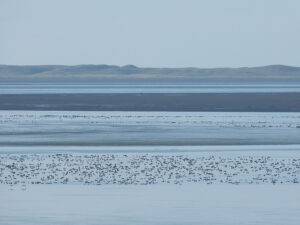
The entire Pacific population of black brant rely on Izembek’s eelgrass. Photo by Kristine Sowl, USFWS.
“Eelgrass is the foundation of this habitat, a keystone for the entire Pacific Flyway,” she said, of Izembek. “It’s a magnet for birds.”
Those birds in turn give people nearby and many hundreds of miles away cause for celebration, as food and nourishment, as the start of shared traditions and activities, and as sign of the changing seasons.
A perpetual homecoming
For many birds, migrating thousands of miles sustains a perpetual Alaska homecoming. This is true for some godwits and geese, for example.
Trumpeter swans, once endangered in the Lower 48 when people hunted these birds in the early 1900s and sold the meat and feathers, breed in forested areas of Interior and Southcentral Alaska. Alaska’s wetlands support up to 80 percent of the U.S. population of trumpeter swans, who winter near ice free coastal waters from Cordova, Alaska, to the Pacific Northwest. They are named for their distinct call and known for their elaborate courtship dance.
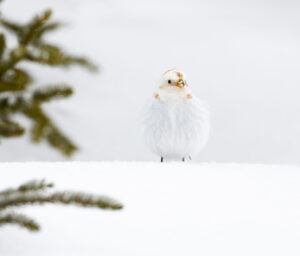
Snow bunting stands in the snow. Photo by Lisa Hupp/USFWS.
Over half the population of North America’s sandhill cranes breed in Alaska, too, with two distinct populations that occur along the Pacific coast and the entire mid-continent of North America. Their long necks and legs make them easy to spot in bogs, marshes and grasslands.
Snow buntings breed on the tundra above the Arctic Circle and often appear as part of the snow itself. They often travel in big flocks, like a flurry of snowflakes, on migrations to the Interior and coastal regions of Alaska or to Canada and the northern Lower 48 states.
Redpolls breed in the Arctic tundra and boreal forests, including in Alaska, and migrate in response to food availability. This means that sometimes people in southern Canada and the northern states will find flocks of them nearby and at their feeders.
Arctic terns do the longest migration of all animals—not in a straight line and with breaks to rest—by flying over 50,000 miles while following the sun to and from Antarctica. They breed in the Arctic before traveling south, maximizing sunlight and food availability.
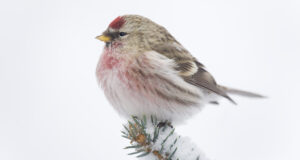
Common Redpoll perched. Photo by Milo Burcham.
For the birds
How we consider migratory birds in policy, decisions, the way we do things here on the ground can affect the health of these birds in big ways.
The birds overviewed in this article are some of the favorite migratory birds of staff from Trustees for Alaska and Audubon, but there are over 250 migratory birds in Alaska, some that breed in Alaska, some that don’t. What they have in common is their reliance on Alaska’s waterways, landscapes, and flyways for their health.
Like migratory birds everywhere, these birds face many challenges on their journeys, including those caused by human activity, such as industrial pollution and construction, along with the associated habitat fragmentation, degradation and loss. Audubon works alongside Trustees and other organizations to protect these birds and critical bird areas like Bristol Bay, Izembek Refuge, and the coastal plain of the Arctic National Wildlife Refuge.
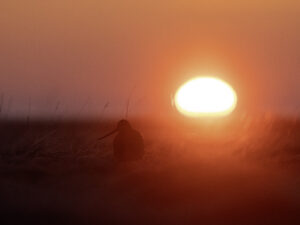
A bar-tailed godwit sits in the Yukon Delta National Wildlife Refuge. Photo by Mark Lindberg.
It doesn’t take long watching and learning about birds to understand the importance of protecting their flyways and habitat. Look outside, try out this bird migration explorer, and look for birds next time you go somewhere new. You might just realize you’re a bit more of a birder than you thought.


